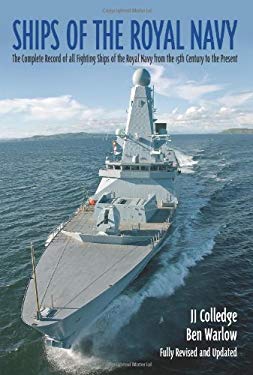
Ships of the Royal Navy. By J J Colledge, Ben Warlow & Steve Bush. Seaforth Publishing, Barnsley, 2020. ISBN 978-1-5267-9327-0
Reviewed by David Hobbs
This is the fifth edition of an encyclopaedic work originally published after a lifetime of research by the noted naval historian J J Colledge. When he died in 1997 Ben Warlow took on the task of updating and revising the entries and for this edition he has been joined by fellow naval analyst Steve Bush.
Some earlier versions ran to a second volume that covered minor war vessels but this latest edition, which runs to 493 pages, incorporates them into a single book. Royal Fleet Auxiliary ships and other naval auxiliaries have been included for the first time, reflecting the fact that in the twenty-first century they take on an increasing number of front line operations in place of frigates and destroyers.
Their inclusion also recognises the fact that they can operate helicopters and regularly embark parties of marines for amphibious operations or humanitarian relief. Considering the wealth of material it contains, this book is not expensive. (You can get an electronic version at Booktopia. See link above.)
From an Australian perspective it contains details a number of vessels ranging from the three warships named Australia to the four named Yarra with many more in between. Each entry gives the type of ship such as destroyer, tonnage, dimensions, armament, builder, launch date and disposal. The use of this standard format allows comparisons to be made and any vessel from the earliest records located and placed into context. It includes ships that were ordered or even laid down but cancelled before their completion. Overall there are more than 15,000 entries, some of them dating from as early at 1300. There are no illustrations and, since the book is written in an ‘A’ to ‘Z’ format, there is no need for an index. Where a ship has been re-named, for instance HMAS Choules, the former RFA Largs Bay, there are entries under both names but the technical details are provided under the first.
I can imagine that some potential buyers might consider that, in the digital age, Wikipedia might be a better option but I would still recommend this book as an important reference. It contains the results of decades of primary research by some of the leading historians in their field and is published with the authority of four previous peer-reviewed editions by one of the world’s leading publishers of naval material. The standardised format allows any ship to be located easily and placed into its historical context and answers the question ‘whatever happened to HMAS…’ in a few succinct words. This edition contains over 200 new entries including the RAN Hunter class frigates and revises a number of earlier entries.
Apart from its obvious use as an immediate source of information about ships across the span of history, this is also an interesting book to dip into and see what catches the eye. Page 195, for instance, contains entries for the Henry Grace Dieu launched at Woolwich in 1514 and the Flower class corvette Hemlock ordered from Harland & Wolff but cancelled in 1941. This edition has replaced earlier editions in my own library and I wholeheartedly recommend it to others as an essential adjunct to other naval historical works.


